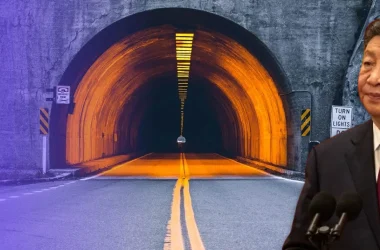Saudi Arabia is currently experiencing an unprecedented megaprojects construction boom. The Kingdom gained fame for projects like Neom, which is its largest urban development project, or Qiddiya, Saudi Arabia’s take on a global entertainment city that could rival Disney World.
Alongside these impressive megaprojects, comes another massive and incredibly ambitious one called the Mukaab, which will be a supertall, golden skyscraper shaped like a cube, with a tall twisted tower inside.
The Mukaab is meant to be the centerpiece of Saudi Arabia’s New Murabba, a real estate development project which aims to be the world’s largest modern downtown project. The Mukaab is expected to bring a lot of economic benefits to its city, the capital Riyadh, and to Saudi Arabia as a whole. However, this didn’t spare the megaproject from facing enormous criticism, thanks to a wide variety of concerns. These concerns include concerns over its design and purpose, religious concerns, human right abuses.
The Mukaab
Saudi Arabia is back with its latest massive megaproject, the Mukaab, which means the Cube in English. The construction for the Cube is expected to start sometime in 2024, and be fully completed by 2030. So, what exactly is the Mukaab supposed to be?
It’s Riyadh’s newest supertall skyscraper, and planned to reach the height of 400 meters, or 1,312 feet, on each side, which explains the Cube name. This height will put it at around the fortieth place in the world’s tallest buildings rankings.
When looking at the Mukaab’s exterior, you could see that its design is inspired by the Najdi architectural style, which is one type of Saudi Arabia’s traditional Islamic architectural styles, while its layout and shape are inspired by the Murabba Palace.
On the Mukaab’s rooftop, there will be an impressive wide rooftop garden that gives it a green and sustainable look. But, the building will also be green in operations, as it will be powered entirely by renewable energy sources, reducing its carbon footprint and promoting sustainable living.
If you think that the Cube’s exterior looks impressive, wait until you see what’s inside it.
The Cube’s large interior will include 121 floors and a floorspace of around 2 million square meters, or 0.77 square miles, which the Saudi Government’s Public Investment Fund says would be large enough to house 20 Empire State Buildings!
Despite this, the Cube isn’t aiming to house 20 buildings, and will instead have a large twisted tower positioned at its center. Think of it like a massive box, with a tall tower inside.
According to the Saudi Public Investment Fund, the Mukaab will encompass a tower atop a spiral base which will be a premium hospitality destination with a multitude of retail, cultural and tourist attractions, along with residential and hotel units, commercial spaces, and recreational facilities.
Aside from the large twisted tower, the Mukaab will also feature some kind of holographic experience that will be used to depict otherworldly scenes to the people inside the building, such as underwater views, futuristic jets, rocks floating, and even fire-breathing dragons flying around.
New Murabba
This very ambitious and futuristic project will be located in the al-Qirawan district of Riyadh, and will be the centerpiece of a larger real estate development project in the Saudi Capital, called New Murabba.
New Murabba will be Riyadh’s new downtown, where technology and sustainability are fused into one. In addition to the Mukaab, New Murabba will feature thousands of new homes, hotels, and retail spaces, as well as offices and leisure facilities, an immersive theater, and a technology and design university.
It will also be a sustainable downtown area with lots of green spaces, and will be a fully walkable area. The company behind this project is the New Murabba Development Company, which notably has the Saudi Crown Prince, Mohammed bin Salman, as its head.
Vision 2030
The Crown Prince’s personal involvement in the project is no surprise, since it’s part of his 2023 Vision for the country. Saudi Arabia’s 2030 Vision was launched by the Crown Prince back in 2016 with three main goals: enhancing the country’s global profile, modernizing the society at par with cultural traditions, and diversifying the Saudi economy away from oil.
The Saudi government is especially focused on the last goal, since Saudi Arabia is the world’s third most oil-reliant country, and petroleum exports contribute to the Kingdom’s GDP by around 40%.
Since oil is a resource that is expected to eventually run out, the Saudi government knew it had to find other sources of economic growth, especially since it’s estimated that Saudi Arabia’s oil reserves will completely run out in 60 years. As a result, plans were made to increase non-oil activities in the Kingdom, and position it as a global trade, tourism, and entertainment hub. Thus, projects like the Mukaab were created.
If you’re wondering how exactly a giant golden cube would contribute to the country’s economy, the Saudi Public Investment Fund has the answer.
Even though the Saudi Public Investment Fund didn’t reveal the project’s costs, which are undoubtedly massive, it gladly revealed that the project is expected to add nearly $48 billion to the Kingdom’s national GDP.
This is because the Saudi government expects the Mukaab to become one of the world’s most popular and unique landmarks, which will attract a lot of tourists and foreign investment. Additionally, the project is expected to help Saudi Arabians by creating 334,000 direct and indirect jobs.
A Controversial Project
even though it promises tangible benefits to the country and its people, the megaproject still received a copious amount of criticism. First of all, the Cube’s design and its utilization of its floorspace were heavily criticized.
When taking a look at the project’s renders, you would see that the only parts of the project with actual floorspace for offices or residential areas are the relatively small corner sections. Even though the Mukaab promises a massive floor space of 2 million square meters, this number isn’t actually impressive when you remember that the Mukaab is big enough to house 20 Empire State Buildings.
The Empire State Building has a floorspace of around 210,000 square meters, and by comparing the Mukaab to it and after doing the math, the Mukaab then should have around 4.2 million square meters of floorspace. This is why the Mukaab’s utilization of its space was criticized, especially since the entire purpose of floorspace is to use them for residential units or offices.
But, maybe this isn’t the main point of the project, and its main purpose is actually to house the twisted tower and the holographic shows.
However, this was also criticized. Many people felt like holographics of UFOs, outer space, and giant people walking around are something straight out of a dystopian movie. If anything, the introduction video that the Saudi Public Investment Fund posted feels like a Sci-Fi movie trailer before everything goes wrong and aliens start attacking.
Jokes aside, the Mukaab’s design also caused an uproar online thanks to its design, and it was accused of attempting to replicate the Kaaba, which is Islam’s holiest site in the Saudi city of Mecca, or take away the attention from it.
Additionally, the project also received criticism due to its massive size, which will undoubtedly take a lot of money and human resources to accomplish. It’s no secret that the majority of workers working on the construction of Saudi Arabia’s megaprojects are foreign or migrant workers, most of them being from Bangladesh, India, or Pakistan.
According to a report by the Human Rights Watch, Saudi employers are known for exploiting these vulnerable groups when it comes to construction projects, forcing them to work for over the specified eight hours without giving them overtime pay in return.
In addition to that, the migrant workers sometimes receive low salaries, and delayed payments. They also sometimes have to work in unsafe construction conditions, and go home to poor living accommodations.
So, it isn’t surprising that Saudi Arabia often comes under fire for how some construction employers treat the migrant labor force, and the construction boom the country is seeing is only adding to this problem.
What’s Next?
To conclude, we can say that the impacts of Saudi Arabia’s megaprojects on the country’s general image and economy can’t be denied, and they truly add so much to the Kingdom and to the quality of living for its people.
However, this shouldn’t come by exploiting workers, or building massive megaprojects that claim to be sustainable and green havens while doing nothing to actually prove that. The Mukaab received tons of criticism thanks to various reasons, which might cause the Saudi government to rethink it. For now, we can only wait and see how this unfolds.
Disclaimer
Please visit and read our disclaimer here.









